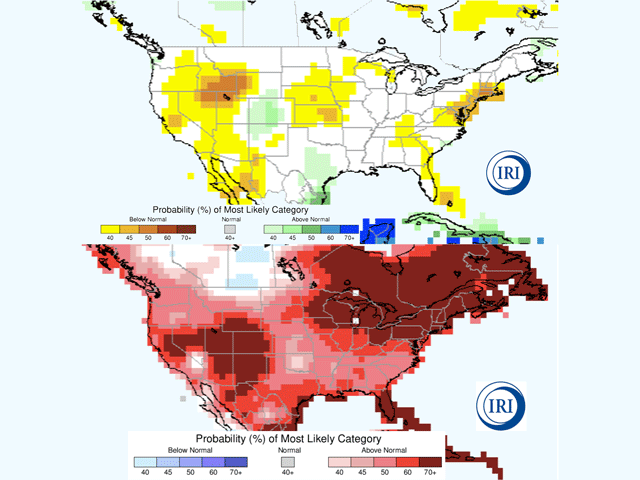Ag Weather Forum
How Could a Developing La Nina Affect Corn Yield?
The equatorial Pacific Ocean continues to change from a strong El Nino (warmer-than-normal equator region waters) to an anticipated La Nina (cooler-than-normal equator region waters). The NOAA Climate Prediction Center's latest outlook for the Pacific Ocean places the chance of the Pacific temperature pattern moving to neutral by the April-May-June period at more than 80%. Odds for La Nina developing by the June-July-August time frame are 62% and 75% in the July-August-September period. In short, La Nina is expected to form in the Pacific by mid to late summer -- during the kernel-filling segment of the corn growing season.
With that high probability of a mid to late summer settling in of La Nina, forecasts are calling for above-normal temperatures and below-normal precipitation for the central U.S. at this important period for corn yield determination. And a look at analog years, which featured a fairly quick change in the Pacific Ocean from El Nino to La Nina, suggests that U.S. corn production will have a tough time posting trendline yields.
DTN long-range forecasters are using the years 2010 and 2020 as the Top 2 analog years for comparison to 2024. Those years saw some notable corn production declines, especially in the last half of the growing season from corn fill through ripening and harvest.
P[L1] D[0x0] M[300x250] OOP[F] ADUNIT[] T[]
Here's how the 2010 year evolved: The first official USDA corn production estimate in August was for record production of 13.365 billion bushels (bb) with an average yield of 165 bushels per acre (bpa), also a record at the time. However, the final production and yield in the January 2011 USDA annual report were both 7% lower than the August numbers, at 12.447 bb for production and yield at 152.8 bpa. In 2010, La Nina set in during the middle and late summer.
Crop year 2020 had similar changes from the first official estimate to the final numbers. The USDA official corn production estimate in August showed production and yield at new records, with 15.278 bb production and 181.8 bpa for the average corn yield. However, the final production numbers, at 14.182 bb with average yield at 172.0 bpa, were down by 7% and 5%, respectively, from the August estimate.
As in 2010, La Nina was established during the late summer of 2020. Production and yield did not have the same percentage changes because of the significant acreage loss in Iowa due to the devastating derecho windstorm in mid-August 2020.
Now, to 2024: With La Nina indicated to form by mid to late summer, there is a notable potential decline in corn production from levels posted in USDA's 2024 Outlook Forum. The Outlook Forum projected U.S. corn production at 15.04 bb in 2024. Applying that 7% potential decline in production in 2010 and 2020 to the 2024 USDA Outlook Forum numbers for corn would give a total corn production number of 13.99 bb --1.05 bb less than the Outlook Forum projection. That, in turn, would mean that the total U.S. corn supply would be less than the projected record total supply of 17.237 bb that the Outlook Forum noted.
La Nina settling in during the last half of the growing season in the analog years of 2010 and 2020 was significant in its shaving of U.S. corn production and suggests that there could be some corn yield and production downgrading as the 2024 season progresses.
More details on DTN's outlook for weather conditions in the upcoming 2024 crop season are available here: https://www.dtnpf.com/….
Bryce Anderson can be reached at Bryce.Anderson@dtn.com
(c) Copyright 2024 DTN, LLC. All rights reserved.






Comments
To comment, please Log In or Join our Community .